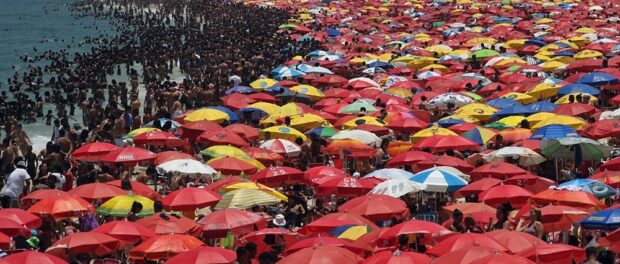
Summer is approaching in Brazil and with it come searing temperatures upwards of 40 degrees Celsius. However, not all areas in Rio de Janeiro’s metropolitan region will experience this heat to the same degree. Studies show that some parts of Rio are more susceptible to high temperatures than others, and with Rio being the city in South America set to experience the worst of climate change, we have additional reason to be aware of and mitigate this reality.
Several local scale factors influence surface temperatures, including vegetation cover, topography, soil type, proximity to bodies of water and the thermal properties of construction materials in the area. Researchers at Rio de Janeiro’s Federal University (UFRJ) correlated a change in land use from rural to urban between 1980 and 2000 to an increase in extreme surface temperatures—surface temperatures above 60 degrees Celsius—in these newly urbanized areas. This phenomenon of increased temperatures due to urbanization is called the Urban Heat Island Effect.
What is the Urban Heat Island (UHI) Effect?
The UHI Effect occurs in cities all over the world and is a result of the varying thermal properties of surface cover in urban areas. On average, a city with one million people or more experiences temperatures 1-3 degrees Celsius higher than its surroundings. In Rio’s metropolitan region, particularly in spring and summer, one can observe temperature differences of up to 25 degrees Celsius when comparing areas with different levels of urbanization.
Some heat layers occur at the surface, while others occur a few meters above the surface. Most research conducted on urban heat islands in Rio de Janeiro focuses on surface temperatures, as opposed to air temperatures (usually two meters above the surface). During the day, surface temperatures tend to be higher than air temperatures.
There are several types of heat islands that can occur, depending on general climate and topography. For example, cities in upper latitudes experience the UHI effect at night when heat stored within the bricks of buildings and the asphalt of streets is released over the nighttime hours. In comparison, cities in tropical latitudes, such as Rio de Janeiro, experience this effect during the day. The UFRJ study explored how surface temperature changes over the course of hours, and a series of three images show that stark divergences in different areas’ temperature emerge during the day, particularly around 1pm local time. Times in the images below are listed in Coordinated Universal Time (UTC), three hours ahead of Rio time.
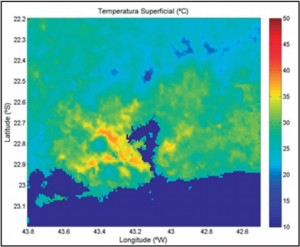
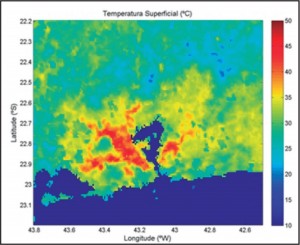
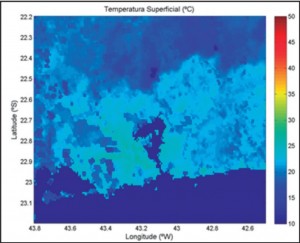
Phenomena that can augment urban heat islands include heat absorption by construction materials, the albedo effect, a lack of vegetation, and the canyon effect. In urban areas, construction materials such as bricks, metal and asphalt increase temperatures by absorbing and reradiating heat. The albedo effect describes how different colors influence the reflection and absorbance of incoming radiation. The dark colors in a city, such as paved streets, absorb heat and increase surface temperatures. A lack of vegetation in urban areas reduces the cooling effect that plants provide through shade and evapotranspiration, a process in which plants release evaporated water into the atmosphere. The canyon effect is a consequence of tall buildings that trap and reflect heat between building walls in vertical urban areas. This allows heat to remain in cities for longer when compared to flatter landscapes where heat is allowed to dissipate out. These factors all contribute to intense heat islands within Rio de Janeiro.
Unusual heat island patterns in Rio de Janeiro
Rio differs from most cities in the distribution of its heat islands. Most cities experience the UHI effect in urban city centers, but researchers in Rio have found that the working class outskirts of the city experience the most intense effects of urban heat islands. According to a study conducted in 2000, areas that experience the most intense heat (between 54 and 60 degrees Celsius at surface temperature) include parts of Centro, the North Zone, the West Zone, Jacarepaguá, and the axis between Niterói and São Gonçalo. Areas experiencing upwards of 60 degrees Celsius in 2000 included Bangu, Caju, Vasco da Gama, Inhaúma, Vicente de Carvalho, BR-116, Nova Iguaçu, Porto Velho and São Gonçalo. Bangu, in particular, holds the record for the highest temperature recorded in Rio.
The coolest temperatures were observed throughout the South Zone, in Barra da Tijuca, in areas of the West Zone like Guaratiba, and in the beachside neighborhoods of Icaraí and Boa Viagem in Niterói. Relatively high temperatures in Botafogo and Copacabana make them exceptions in the South Zone. This is likely due to relatively concentrated urbanization and low vegetative cover in these neighborhoods compared to other South Zone neighborhoods.
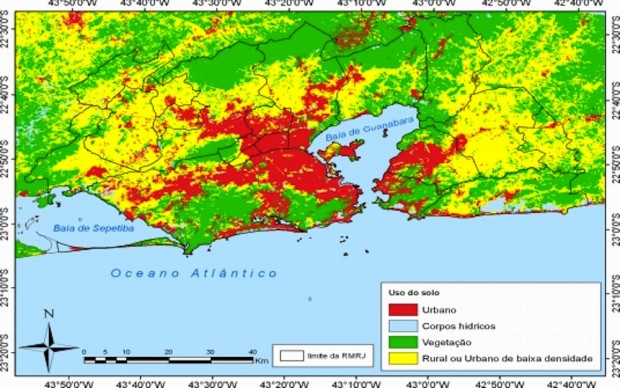
Why heat islands matter
Studying heat islands is important for the health and quality of life of city residents. Studies have shown that extreme heat can be particularly dangerous to the health of vulnerable populations. A recent study in New York City linked extreme heat to increased incidences of mortality in elderly populations. Not only are heat islands an issue of health, they are an issue of inequality as well. The same study in New York City found that heat-related illnesses and mortality in senior citizen populations are higher in poorer areas. While a study like this has yet to occur in Rio de Janeiro, it is clear that there is an unequal distribution of agreeable temperatures within the city. In general, the richer areas of the South Zone and Barra da Tijuca experience the least intense temperatures while the city’s poorer peripheral neighborhoods and favelas experience intense heat. Common heat island-related illnesses include heat stroke, heat exhaustion, heat syncope and heat cramps. Exposure to high temperatures can have serious implications for people with diabetes, cardiovascular conditions and cognitive health problems like depression, Parkinson’s disease or dementia. These heat island-related health issues may be compounded by unequal access by these very same regions to health services. This means that urban heat islands have a significantly more intense effect on those who have fewer resources to combat them.
Solutions
Although intense heat is a regular experience for all Cariocas in the summer, there is little discussion of urban heat islands and few projects working explicitly to combat them. In 2012, city authorities promised to plant 34 million trees in order to mitigate greenhouse gas emissions from the Olympic Games. These trees could have also provided an additional benefit of mitigating urban heat islands. Unfortunately, the promise to plant 34 million trees by December 2015, has barely been fulfilled. Research this year suggests only 8.1 million trees will be planted by the Olympics next year. Researchers in Rio have called for an increase in vegetative cover as well as an improvement in construction materials in order to mitigate extreme heat.
Apart from increasing vegetation cover, the United States Environmental Protection Agency recommends three other strategies for communities looking to reduce UHI effects: solar reflective “cool” pavements using a reflective aggragate, binder or surface coating; cool roofs which use white or white-coated roofing membranes to reflect solar radiation; and green roofs which are wholly or partially covered with vegetation. Given the heterogeneity of Rio de Janeiro’s urban landscape and the innovation that is characteristic of cariocas, especially within favelas, the potential for implementation of these strategies presents an interesting area for action.
